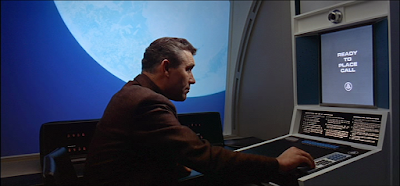Film Review: 2001 A Space Odyssey
2001 A Space Odyssey is a Science Fiction film that was directed by Stanley Kubrick in 1968. Stanley Kubrick's films famously have a cold almost disconnection to the characters and their emotions as he never uses close ups to the faces of the characters meaning that audiences never get to experience those raw emotions up close which can be seen in figure 1. He also often uses symmetry in his camera directing which can give off the impression of a almost clinical and controlled effect. "Maybe only rocket science and deep space could absorb Kubrick’s famous coldness and control and tendency to visionary gigantism." (Bradshaw, 2014) This also relates to the dialog used in the film which is minimal and is manly used to tell small parts of the story.
Kubrick designs the film so that it is nearly 30 minutes before any proper dialog is spoken and it is even long still until a plot for the film is shown to be developing. He boils the film down to the visual effects and the use of colour and camera shots "He reduces each scene to its essence, and leaves it on screen long enough for us to contemplate it, to inhabit it in our imaginations." (Ebert, 1997) Kubrick is not so interested in the storyline or plot, but rather developing new camera angles and capturing a designers essence of the film.
Often Kubrick will explore symmetry or the use of rotund shapes in his camera work which can be seen in figure 3. For this film these shapes and designs work really well in relating to the themes of space as they give the film a futuristic feel.
Overall this film was stunning to look at but the story line lacked interest, however no matter a persons opinion on this film, 2001: A Space Odyssey went on to inspire many other science fiction films such as Interstellar and it used many innovative camera techniques which developed new and different ways of using a camera to create a space and complement a running theme.
Bibliography:
Bradshaw,P (2014) 2001: A Space Odyssey review-still visionary after all these years.
Found at: https://www.theguardian.com/film/2014/nov/27/2001-a-space-odyssey-review-rerelease
(Used on 25/10/16)
Costa,L (2011) The visual effects in 2001 - A Space Odyssey.
Found at: http://www.leocosta.me/the-visual-effects-in-2001-a-space-odyssey/(Used on 25/10/16)
Ebert, R. (1997). Great Movie 2001: A Space Odyssey.
Found at: http://www.rogerebert.com/reviews/great-movie-2001-a-space-odyssey-1968 (Used on 25/10/16)
Illustrations:
All illustrations ( figures 1, 2, 3) Kubrick, S. (1968) '2001: A Space Odyssey'
Found at: https://film-grab.com/2010/07/06/2001-a-space-odyssey/
(Used on 25/10/16)
 |
| Figure 2. Hostess |
 |
| Figure 3. Star Ship Corridor |
Overall this film was stunning to look at but the story line lacked interest, however no matter a persons opinion on this film, 2001: A Space Odyssey went on to inspire many other science fiction films such as Interstellar and it used many innovative camera techniques which developed new and different ways of using a camera to create a space and complement a running theme.
Bibliography:
Bradshaw,P (2014) 2001: A Space Odyssey review-still visionary after all these years.
Found at: https://www.theguardian.com/film/2014/nov/27/2001-a-space-odyssey-review-rerelease
(Used on 25/10/16)
Costa,L (2011) The visual effects in 2001 - A Space Odyssey.
Found at: http://www.leocosta.me/the-visual-effects-in-2001-a-space-odyssey/(Used on 25/10/16)
Ebert, R. (1997). Great Movie 2001: A Space Odyssey.
Found at: http://www.rogerebert.com/reviews/great-movie-2001-a-space-odyssey-1968 (Used on 25/10/16)
Illustrations:
All illustrations ( figures 1, 2, 3) Kubrick, S. (1968) '2001: A Space Odyssey'
Found at: https://film-grab.com/2010/07/06/2001-a-space-odyssey/
(Used on 25/10/16)




Comments
Post a Comment